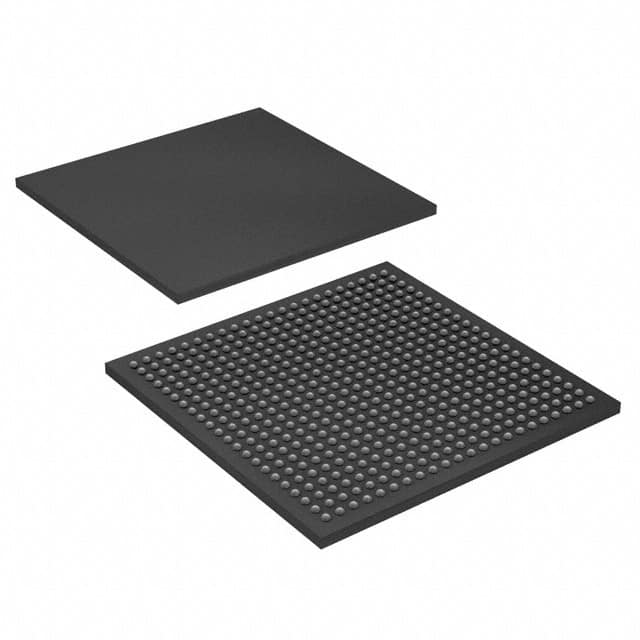Consulte las especificaciones para obtener detalles del producto.

EP3C40F484C8
Product Overview
- Category: Programmable Logic Device (PLD)
- Use: EP3C40F484C8 is a PLD used for digital logic design and implementation.
- Characteristics:
- High-performance device with low power consumption
- Offers high-speed data processing capabilities
- Provides flexibility in designing complex digital circuits
- Package: The EP3C40F484C8 comes in a 484-pin FineLine BGA package.
- Essence: EP3C40F484C8 is an advanced programmable logic device that enables the implementation of complex digital designs efficiently.
Specifications
- Logic Elements: 39,600
- Memory Bits: 1,152 Kbits
- Embedded Multipliers: 112
- Maximum User I/O Pins: 317
- Operating Voltage: 1.2V
- Speed Grade: C8
Pin Configuration
The EP3C40F484C8 has a detailed pin configuration as follows:

Functional Features
- High-density programmable logic device suitable for various applications
- Supports a wide range of digital functions and protocols
- Flexible I/O options for interfacing with external devices
- Efficient utilization of resources for optimized performance
- Integrated memory blocks for efficient data storage and retrieval
Advantages and Disadvantages
Advantages: - High-performance device with low power consumption - Offers flexibility in designing complex digital circuits - Supports a wide range of digital functions and protocols - Efficient utilization of resources for optimized performance
Disadvantages: - Limited number of user I/O pins - Higher cost compared to simpler programmable logic devices
Working Principles
The EP3C40F484C8 utilizes programmable logic elements and embedded memory blocks to implement digital logic designs. It operates based on the principles of configurable logic, where the user can program the device to perform specific functions by configuring the interconnections between logic elements.
Application Field Plans
The EP3C40F484C8 is suitable for various application fields, including: - Communication systems - Industrial automation - Automotive electronics - Consumer electronics - Medical devices
Alternative Models
- EP3C25F324C8: A lower-density version with similar features
- EP3C120F780C8: A higher-density version with increased logic elements and memory bits
- EP4CE115F29C7: An alternative model from a different series with comparable specifications
Note: The above list is not exhaustive and there may be other alternative models available in the market.
This encyclopedia entry provides an overview of the EP3C40F484C8 programmable logic device, including its basic information, specifications, pin configuration, functional features, advantages and disadvantages, working principles, application field plans, and alternative models.
Enumere 10 preguntas y respuestas comunes relacionadas con la aplicación de EP3C40F484C8 en soluciones técnicas
Sure! Here are 10 common questions and answers related to the application of EP3C40F484C8 in technical solutions:
Q: What is EP3C40F484C8? A: EP3C40F484C8 is a specific model of Field-Programmable Gate Array (FPGA) manufactured by Altera.
Q: What are the key features of EP3C40F484C8? A: Some key features of EP3C40F484C8 include 40,000 logic elements, 484-pin package, and support for various I/O standards.
Q: What are the typical applications of EP3C40F484C8? A: EP3C40F484C8 is commonly used in applications such as industrial automation, telecommunications, automotive systems, and high-performance computing.
Q: How can EP3C40F484C8 be programmed? A: EP3C40F484C8 can be programmed using Hardware Description Languages (HDLs) like VHDL or Verilog, which describe the desired functionality of the FPGA.
Q: Can EP3C40F484C8 be reprogrammed after initial programming? A: Yes, EP3C40F484C8 is a reprogrammable FPGA, allowing for flexibility in design changes or updates.
Q: What tools are available for programming EP3C40F484C8? A: Altera provides Quartus Prime software, which includes a suite of tools for designing, simulating, and programming EP3C40F484C8.
Q: Does EP3C40F484C8 support communication protocols? A: Yes, EP3C40F484C8 supports various communication protocols such as UART, SPI, I2C, Ethernet, and PCIe.
Q: Can EP3C40F484C8 interface with external devices? A: Yes, EP3C40F484C8 has a wide range of I/O pins that can be used to interface with external devices like sensors, displays, or memory modules.
Q: What are the power requirements for EP3C40F484C8? A: EP3C40F484C8 typically operates at a voltage range of 1.2V to 3.3V, depending on the specific design requirements.
Q: Are there any development boards available for EP3C40F484C8? A: Yes, Altera offers development boards like the DE0-Nano board, which can be used for prototyping and testing designs using EP3C40F484C8.
Please note that these answers are general and may vary based on specific design considerations and requirements.

